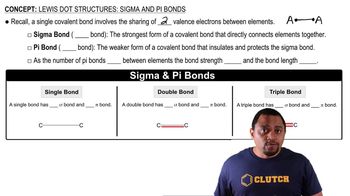Write orbital diagrams (boxes with arrows in them) to represent the electron configurations—without hybridization—for all the atoms in SF2. Circle the electrons involved in bonding. Draw a three-dimensional sketch of the molecule and show orbital overlap. What bond angle do you expect from the unhybridized orbitals? How well does valence bond theory agree with the experimentally measured bond angle of 98.2° ?
 Tro 6th Edition
Tro 6th Edition Ch.11 - Chemical Bonding II: Molecular Shapes, VSEPR & MO Theory
Ch.11 - Chemical Bonding II: Molecular Shapes, VSEPR & MO Theory Problem 59
Problem 59Which hybridization scheme allows the formation of at least one p bond? sp3, sp2, sp3d2

Verified Solution
Key Concepts
Hybridization

Sigma and Pi Bonds

Types of Hybridization

Write orbital diagrams (boxes with arrows in them) to represent the electron configuration of carbon before and after sp3 hybridization.
Write orbital diagrams (boxes with arrows in them) to represent the electron configurations of carbon before and after sp hybridization.
Which hybridization scheme allows the central atom to form more than four bonds? sp3, sp3d, sp2
Write a hybridization and bonding scheme for each molecule. Sketch the molecule, including overlapping orbitals, and label all bonds using the notation shown in Examples 11.6 and 11.7. a. CCl4
Write a hybridization and bonding scheme for each molecule. Sketch the molecule, including overlapping orbitals, and label all bonds using the notation shown in Examples 11.6 and 11.7. b. NH3